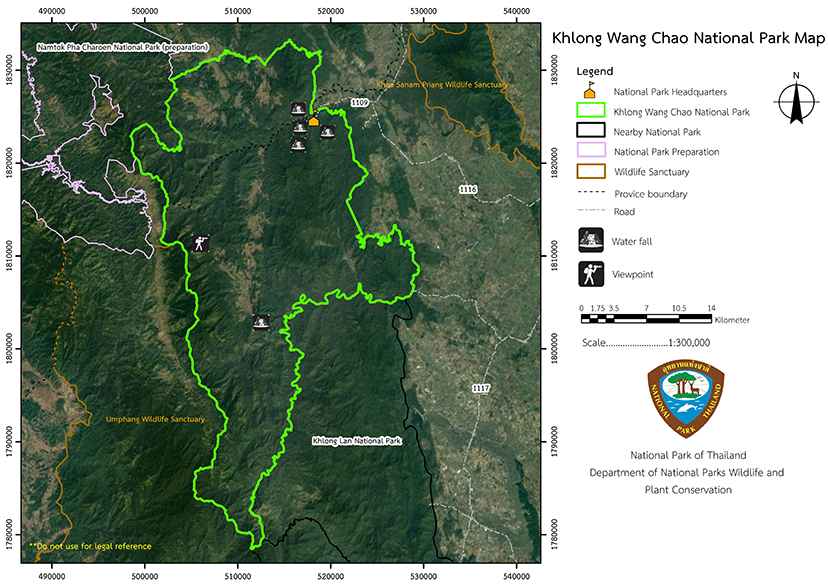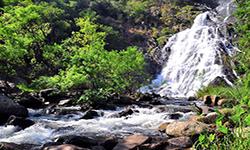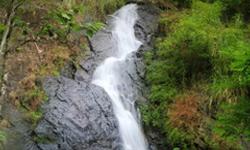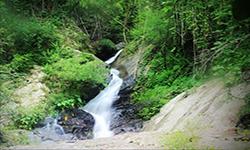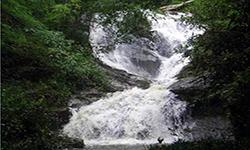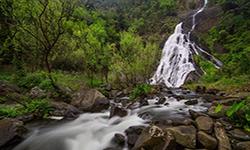Khlong Wang Chao National Park
Contact Location : Khlong Wang Chao National Park, 446 Moo 22, Kosamphi Sub-district, Kosamphi Nakhon District, Kamphaeng Phet Province 62000
Telephone Number : (+66) 9 3790 0935 , (+66) 8 1128 3903
Email : np12.khlongwangchao@hotmail.com
Facebook : Klong Wang Chao National Park
Information
Khlong Wang Chao National Park encompasses the districts of Khlong Lan District, Kosamphi Nakhon Minor District, Kamphaeng Phet Province, and Wang Chao Minor District, Tak Province, and is comprised entirely of forest. It is an upstream forest due to the fact that it holds a tributary of the Ping River, and it is popular as it has a variety of wildlife and beautiful natural features such as waterfalls, caves, cliffs, and natural springs, It , covers an area of 466,875 Rai or 747 square kilometers.
Background
On 7 December 1988, Lieutenant Colonel Mr. Sanan Khachonprasat, Minister of Agriculture and Cooperatives, visited Kamphaeng Phet to inspect deforestrations in the Reserve Forests of Khlong Wang Chao and Khlong Suan Mak, in Khlong Lan District, and Mueang District, Kamphaeng Phet Province. It was recorded and there was an order that the area should be surveyed in order to establish a National Park.
On December 8, 1988, a resolution was passed designating the forest area as a National Park. conserve natural resources and maintain natural conditions.
The National Park Division issued a letter (most urgent) No. Ko So 0713/1499, dated December 20th, 1988, to the Royal Forest Department. Then the Department issued an order No. 1914/2531, dated December 21st, 1988, appointing Mr. Vitoon Uratchanoprakon, Forestry Technical Officer Level 4, to survey the forest, and the surrounding area in Tak Province and be designated a National Park.
According to the survey results submitted by Khlong Wang Chao National Park with a letter No. Ko So 0713 (Wo Cho)/11, dated February 15th, 1989, the Khlong Wang Chao Forest area, located within the Khlong Suan Mak Forest in Kamphaeng Phet Province, was designated a National Reserved Forest in accordance with Ministerial Regulation No. 488 (1972) published in the Government Gazette, Volume 89, Part 175, dated November 21st, 1972. Pradang – Wang Chao Forest in Mueang Tak District was designated a National Reserved Forest in accordance with Ministerial Regulation No. 10 (1964), announced in the Government Gazette, Volume 81, Section 116, dated December 8th, 1964. The area is described as rainforest with numerous stunning natural features, suitable for the establishment of a National Park.
Later, a royal decree established the boundaries of Pra Dang Forest and Wang Chao Forest in Chiang Thong Sub-district, Mueang Tak District, and Khlong Wang Chao and Khlong Suan Mak forests in Kosamphi Sub-district, Mueang Kamphaeng Phet District, and Pong Nam Ron Sub-district, Khlong Lan District in Kamphaeng Phet Province, as a National Park, announced in the Government Gazette on August 29th, 1990, Volume 107, Chapter 158, and became the 63rd National Park in Thailand.
Note : After paying the entrance fee to the National Park, please carry the receipt for inspection.
466875 rai. (747 square kilometers)
|
|
|
|
|
|
|
|
|
Nature trails ⇔Trekking ⇔ Forest Viewpoint ⇔ visit Waterfall ⇔ Bird ,butterfly ⇔ Camping
Welfare shop : Open daily from 8.30 – 16.30 hrs.
During the holiday season it opens from 08:00 - 20:00 hrs.
National Park Headquarters : AIS
|
|
Khlong Wang Chao National Park is located on the western mountain range's southwestern border with the central plains. The geological topography is tower karsts in complex, folded mountainous. The mountain line runs through Khao Thanon Thongchai in a north-south direction. The plains in the area's center are comprised of a small pan, two basins, and an area of between 3.2 and 8 square kilometers. Khao Yen, Khao Son, Khao Tao Dam , Khao Kanoon, Khao Kha Lang, Khao I Loe Koe, Khao Wang Chao, Khao Pang Yai, Doi Luak, and Khao Wung Kasang are the primary mountain ranges. The area ranges in elevation from 200 to 1,898 meters above sea level, with the breathtaking Khao Yen summits to the west of the highest point. Khlong Wang Chao National Park is part of watershed Ping River's catchment area. It consists of two river basins. One is Khlong Wang Chao basin, composing of Khlong Yama, Khlong Wang Chao, Khlong Khun Mak, and Khlong Yang. Another is Khlong Suan Mak basin, composing of Phrai Canal,Wung Kasang Canal, Plu Canal, I Mi Canal, Som O Canal, Pang Yai Canal, Suan Mak Canal, Tao Dam Creek, Phu Yai Lao Creek, Nai Pu Creek, Kha Khaeng Creek, Champa Canal, Tano Canal, and Pang Khop Canal. |
|
The Khlong Wang Chao National Park’s weather is influenced by the southwest monsoon from mid-May to mid-October, resulting in high humidity, a lot of clouds, and heavy rain, with an average annual rainfall of 1,318 millimeters. Between mid-October and mid-February, the northeast monsoon brings colder weather, clear skies, and a minimum temperature of 14 degrees Celsius in January. Summer is the transition period between the two monsoons. April's maximum temperature is 36 degrees Celsius. However, the annual average temperature is 26 degrees Celsius.
|
|
|
|
The Khlong Wang Chao National Park contains five distinct types of forest, and these ecosystems are mostly mixed deciduous forests. They cover approximately 65 % of the park, between 200 and 1,000 meters above sea level. Trees in the forests include Teak, Terminalia alata Heyne, Iron Wood, Burma Padauk, Canarium subulatum, Melanorrhoea ustata, Thai bungor, Tomentose wrightia, Phoebe paniculata Nees, Albizia odoratissima, Sterculia villosa, and others are among the wood species. Additionally, bamboo mingles exist, including White Bamboo andGigantochloa albociliata Munro. It serves as a habitat and refuge for animals such as Gaur, Barking Deer, Sambar Deer, Fishing Cat, Wild Boar, rodents, and wildfowl. To the west, the tower karst topography is covered by an hill evergreen forest in the west along north-sound line From 1,000 meters above sea level. Trees in the hill evergreen forest include the Chinkapin, Castanopsis tribuloides, Endospermum diadenum, Engelhardtia spicata Lechen, Anneslea fragrans, Garcinia speciosa Wall, Sapium baccatum, Lithocarpus cerifer, Schima wallichii Korth, The lower plant species are densely grown such as ferns, Paper Mulberries, Amomum testaceum, Arundo donax, Phragmites karka, and Calameae, are relatively dense at lower levels. During certain seasons, large animals such as gaur visit the area and smaller creatures include Phayre's flying squirrel, hite-bellied Flying Squirrel, Scarlet Minivet, Small Minivet, Chestnut-bellied Nuthatch. Dry evergreen forests are scattered throughout the area's central valley. It is located between 400 and 1,000 meters above sea level. The wood species include Homalium grandiflorum, Thai bungor, Chukrasia velutina, Bhesa robusta, Bischofia javanica, Cananga odorata, Mitragyna diversifolia, Duabanga grandiflora, Common Fig, Arenga pinnata, Caryota urens, Livistona speciosa. There is also a habitat, food source, and refuge for animals such as the Gaur, Sambar Deer, Lesser Mouse Deer, Asian Golden Cat, Leopard, Black Giant Squirrel, Great Hornbill, Wreathed Hornbill, and Great Barbet. The Deciduous Dipterocarp Forest occurs in fragments and follows a ridge of small hills on the eastern and northern boundaries of the National Park. Trees including Burma Sal, Shorea siamensis, Hairy Keruing, Dipterocarpus tuberculatus, Mitrayna Korth, Indo-Chinese Tanoak, Quercus kerrii Craib, Great Elephant Apple, and Buchanania latifolia were discovered at between 200 and 800 meters in elevation with grasses such as Cynodon dactylon, Imperata cylindrica, Heteropogon contortus (L.) P.Beauv. ex Roem. et Schalt. found on the lower ground. There have been sightings of Wild Boars, Barking Deer, Clouded Monitor Lizards, and the Elongated Tortoise. The coniferous forests (pine forest) are sparsely distributed Along the ridge and on the central summit, at between approximately 900 and 1,200 meters above sea level. Species such as Khasiya Pine , Lithocarpus cerifer, Schima wallichii, Anneslea fragrans, and Tristaniopsis burmanica are present, alongside wild animals such as Chamois, Wild Boar, Serows, Pig-Tailed Macaques, Large Indian Civets, Asiatic Brush, and Yellow rajah rat.– The area is surrounded by water sources and numerous waterways. Animal : Additionally, the Wreathed Hornbill, Laced Woodpecker, Black-Capped Kingfisher, and Little Grebe are all present in the National Park area, as well as the Glandular Frog, the Rice Field Frog, the Aquatic Frog, the Tubercular Breasted Frog, the Malayan Giant Frog, the Painted Chorus Frog, the Giant Jungle Toad, the Ornate Narrow-Mouthed Frog, the Medilan-Striped Burrowing frog, the Indochinese Dwarf Toad, and the Common Puddle Frog. Fish present include the Goldfin tinfoil barb, Sidestripe rasbora, Schwanfeld' s tinfoil Barb, Mahseer Barb, Siamese Rock Catfish, the Striped Snakehead Fish, Grey Featherback, and Naked Catfish, among others. |
How to get there by car :
- From Kamphaeng Phet, travel along the Asian Highway (A1) to Wang Chao Market intersection in Tak Province then turn left to Ban Na Bot along Provincial Highway No. 1110. Proceed approximately 3 kilometers to Ban Den Kha intersection. At the Intersection, turn left and right to Ban Nong Dan for another seven kilometers to the headquarters of Khlong Wang Chao National Park. The total distance is 28 kilometers. It is accessible by car all year round as it is a paved road all the way.
- From Kamphaeng Phet, take Asia Road (A1) to Tak Province, and approximately 500 meters before the Ban Wang Chao intersection,bear left toward Ban Lo Kho. The total distance from Ban Nong Dan to the National Park Headquarters is approximately 30 kilometers and It is accessible by car all year round on paved road.
- Khlong Wang Chao National Park Ranger Station Wo Cho No. 1 (Ko Roi)
- Khlong Wang Chao National Park Ranger Station Wo Cho No. 2 (Khlong Mot Daeng)
- Khlong Wang Chao National Park Ranger Station Wo Cho No. 3 (Pang Sangasi)
- Khlong Wang Chao National Park Ranger Station Wo Cho No. 4 (Mae Yama)
- Khlong Wang Chao National Park Ranger Station Wo Cho No. 5 (Lo Kho)
- Khlong Wang Chao National Park Ranger Station Wo Cho No. 6 (Pha Phueng)
- Khlong Wang Chao 101 (Wang Chao 1)
- Khlong Wang Chao 102/1
- Khlong Wang Chao 102/2
- Khlong Wang Chao 105
- Khlong Wang Chao 106
- Khlong Wang Chao 202/1 (Kang Khen Dong)
- Khlong Wang Chao 202/2 (Kang Khen Dong)

